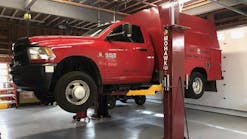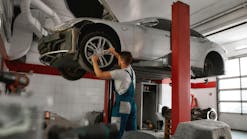Tech Tip: Seven simple steps to ensure operator safety
Minimizing the risk of accidents in the workplace is a top priority, and it is especially important when working with pneumatic power tools. Ensuring that all safety precautions have been taken to protect the health and wellbeing of operators is vital. With this in mind, here are seven simple steps to reduce the risk of accidents and improve operator safety.
1. Limit vibrations and noise
Excessive vibrations and noise can have devastating long-term consequences for an operator. For example, prolonged exposure to vibrations can lead to hand-arm vibration syndrome (HAVS) which can result in a loss of sensation in the hand. At the same time, extremely loud noises or continued exposure to loud noises can result in loss of hearing.
The tool’s vibration level and the length of exposure time are the two key factors that indicate whether an operator will be at risk from HAVS. Vibration and noise can both be minimized by choosing tools with low levels, evaluating the work pattern, and wearing appropriate PPE, such as ear protectors.
2. Check that the tools have appropriate safety features
- Grinders – Key safety features on these tools are overspeed shut-off functions, autobalancers, and guards. The first – overspeed shut off – prevents a grinding wheel from speeding faster than it should, and therefore reduces the risk of disc burst which would ultimately injure the user. Secondly, autobalancers stabilize a tool, greatly reducing vibration. Finally, guards protect the operator from any shrapnel in case the disc breaks apart.
- Impact wrenches – An important feature to consider is the torque limited function which enables torque level control, mainly on tightening applications where torque control is essential, such as tire changing or shipyards. Tools whose torque is limited by an airflow modification have lower vibration than those with a mechanical modification.
3. Perform regular maintenance
Regular servicing is vital when ensuring the safety of equipment as a tool that is well looked after and properly maintained will have less risk of failing. Maintenance should be carried out according to the tool’s manual, for example, components that wear most frequently and therefore need maintaining in grinders are the blades and bevel gears. Blades should be inspected every 500 hours, and the interval for bevel gears every 1,000 – 2,000 hours depending on the tool.
4. Know how to use the tools safely
Always follow manufacturers’ recommendations and best practices on tool usage. Ensure operators are fully trained to use equipment safely and to follow the company’s agreed safety procedures. Furthermore, make sure you are using the right tool and abrasive for the job.
5. Wear appropriate PPE
Personal protection equipment (PPE) helps to shield the operator against potential hazards. It is critical that operators always use all recommended safety equipment when operating pneumatic tools, including sturdy gloves to protect hands from the elements, helmets and safety goggles in case of any debris, and ear protectors for noise.
6. Make sure the environment is safe
Consider the environment surrounding the job and ensure you take appropriate precautions. For example, is it a confined space, or is the job at height? Grinding can create fine dust particles, which if inhaled can cause health and safety issues for the operator. Therefore, always grind in a well-ventilated space. Also, always ensure that the workpiece is secure, and you have a stable operating position. For instance, if you are working at height, remember to implement the best practices to help to prevent tool drops.
7. Ensure you have a good air line set up
Think about the whole tool system including the air line. All pneumatic tools require clean, lubricated air and a dynamic pressure of 90 PSI (6.3 bar) to work safely. If the pressure is any higher than this, it could negatively affect the tools’ lifespan and risk operator’s safety. Air pressure can be adjusted with an FRL (filter, regulator, lubricator) so it is important to include one in the air system near the tool. You can also enhance the safety of your air line by adding an air fuse to its set up, this will prevent you from hose whiplash.
By considering these seven points you will improve safety associated with using tools in the workplace, therefore protecting operators. An additional benefit to these responsible practices is that you will improve efficiency too.
Information provided by Chicago Pneumatics


